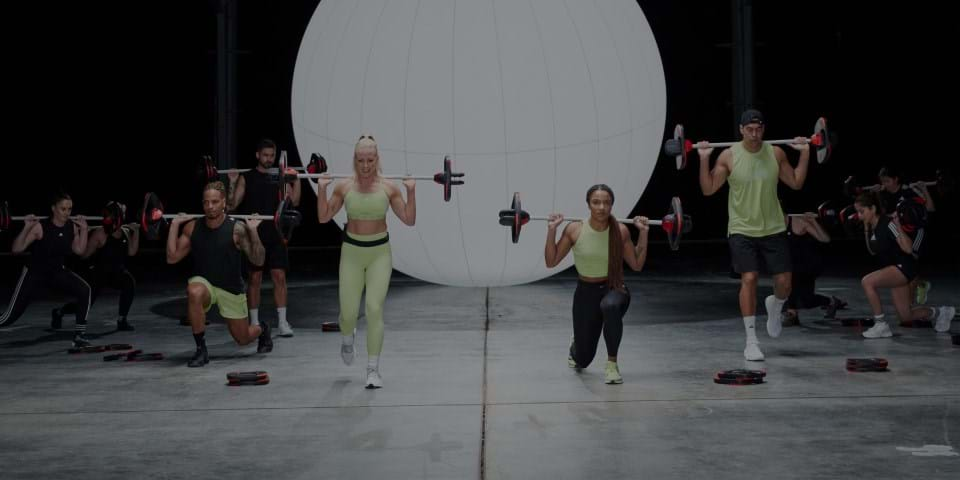I’ll never forget my own experience of “the choke”. It was 2012, and I’d recently moved from the UK to New Zealand, where I was getting mentored as a BODYPUMP™ teacher by Masterclass Presenter Will Pritchard. I’d already been teaching the program for four years, so was relatively experienced, but I found the pressure of standing on stage next to Will to be overwhelming. Team teaching his packed Monday night class, I felt like an impostor. I felt I wasn’t good enough to teach with him, and it really got in my head.
I would start getting stressed a few days beforehand. By the time Monday morning rolled around, I’d be totally freaked out. Normally everything would end up being fine, but one day I was teaching the Back Track and it felt as if my entire left arm had given out. I was trying to Clean & Press, but my left side felt like water. I could hear Will encouraging me to keep going but I was trapped in a nightmare, seeing the sea of faces in front of me and feeling like the biggest failure on earth. I can’t quite recall how I got through it, but I may have even had to put the bar down and coach the rest of it because it felt as though my body had betrayed me. The pressure had manifested itself physically.
FEELING THE PRESSURE
Choking under pressure is the phenomenon where a person freezes and is unable to perform when it matters most, despite possessing the necessary skills and expertise. It’s often accompanied by heightened anxiety, self-doubt, and increased self-awareness, leading to a decline in performance.
When we “freeze”, our bodies are reacting to a perceived threat in our environment. In the studio, this may look like: fearing judgement from a member or another Instructor, forgetting the choreography, missing vital coaching cues, or concern we won’t be able to perform physically.
When we choke, our body enters fight or flight mode and floods the body with stress hormones including cortisol and adrenaline. As a result, you may experience an elevated heart rate, increased breathing, and sweating (even more than normal). It can also impair our working memory, making it difficult to process information and make decisions. In practice, this may mean you forget the choreography or even how to coach an exercise.
There are certain times in our teaching life when we’re more susceptible to choking. For example, when launching a new release, covering someone else’s class, teaching a new program for the first time, or team-teaching with someone you’re intimidated by. Les Mills Ambassador Marlon Woods recalls his own experience of choking while filming Masterclass:
“Presenting on Masterclass is scary […] Until you’ve done it, you can’t imagine the pressure and the stress and the anxiety and the worry. You’re stressed out all week. You mess something up in a rehearsal on the Monday and then you fix it on the Tuesday. But then you mess something else up on Wednesday and then you realize you’re filming on Friday. And then all of a sudden, you’re in front of the cameras and the lights and all of the people…. and you forget how to even stand up. Seriously, for the entire first half of the Upper Body Warm-Up of BODYCOMBAT 82, I was panicked that I was going to fall over.”

STRATEGIES TO PREVENT CHOKING
The problem with choking, beyond the horror of the moment of decline, is that it can have long-term repercussions for your confidence as a teacher. Fortunately, there are strategies to help you handle the pressure and optimize your performance. Here are six top tips:
- LEARN YOUR CHOREOGRAPHY INSIDE OUT
When you’re confident in the choreography, you’re already two steps ahead. If you’re up in your head wondering if you’re going to miss that musical shift in the Squat Track, you’re more likely to succumb to doubt and pressure.
“I have a ‘pressure practice’ idea,” says UK Trainer Justin Riley. “This is where I play the Masterclass footage with Presenter voice off and pretend to teach the track to members. I’ll move with the music and coach out loud whilst also dealing with external distractions like the dog, the TV in the background, or even answering a question from someone in the house. This helps me to determine how well I truly know the track. If I stay on track with all this happening at once, then I’ve got it! If I lose my way, I’ll check the Masterclass footage and get back on track. I’ll then re-do the same practice of that track and correct the part that threw me. This is to add an extra level of realism to practicing at home.
“In a live class situation, there are always distractions or moments of impromptu connection that will take your attention away from purely teaching the choreography. It’s very easy to focus on just the music and moves, which can give you a false sense of security that you’ve truly learnt it well enough to teach and deal with distractions.”
- VISUALISE YOUR SUCCESS
Visualization is a powerful tool that can help you to feel more comfortable about the class ahead. Studies have shown that trainee doctors felt more confident and performed better when they used imagery to enhance their preparation for medical procedures.
Try imagining your best class ever – you know the choreography 100 per cent, your coaching is next level, and your members are having the time of their lives. Visualize the scenario in as much detail as possible – employing all of your senses. Hear the music on the speaker, feel the microphone against your cheek, see your members in front of you. Writing affirmations could also be helpful. Future statements such as “I rocked my BODYCOMBAT class”, “I delivered my choreography perfectly”, or “My members felt seen” may increase your confidence and help you to perform in the moment.
- OWN YOUR SPACE
When I first started teaching in Les Mills clubs in New Zealand, I was very shy, and almost didn’t want to be seen by the members. Another Instructor, who was mentoring me, kept encouraging me to move closer to the front of the stage, to “own my space”. It’s something I’ve noticed in other novice Instructors too – we feel uncomfortable and want to hide ourselves. Standing up front and center can feel strange, but it will automatically increase members’ confidence in you.
If you’re small – like me – there are other tricks you can employ to own your space. I was advised to imitate Lisa Osborne, who was described to me as “the queen of making herself appear bigger than she is”. The stage in Studio 1 at Les Mills Auckland City is huge, and it can be easy to feel dwarfed by that space if you’re not confident. For months, I watched the way Lisa used her voice, her arm lines, and the way she moved around the stage to “fill” the space with her energy.

- TRY BREATHWORK
Breathwork is enjoying a surge in popularity thanks to the rise of meditation apps and books such as James Nestor’s ‘Breath’. If you’re feeling anxious before class, practising controlled breathing techniques can help you manage the pressure of the situation.
“One of the biggest benefits of cultivating a regular breath practice is that we learn how to balance our nervous system, which helps us regulate every other vital function in the body,” says BODYBALANCE™ Presenter Fraser Beck. “When we become overly stressed or tense, the sympathetic branch of our autonomic nervous system is turned on. Contrastingly, when we’re in a state of rest, relaxation and digestion, it’s our parasympathetic nervous system that is activated.”
If you’re feeling wound up and tense before class, try to find a quiet space (even the toilets!) where you can take a few minutes to calm your breathing before you face the class.
- GET A PRE-CLASS ROUTINE
Establishing a ritual before we teach can get us in the right mindset, signaling to the body that it’s time to perform.
“Strong black coffee does the trick!” says Glen Ostergaard. "A pre-class ‘priming workout’ helps me get in the zone – a stretch and kettlebell swings are great for firing the posterior chain… snatches, cleans just before BODYPUMP. A run before RPM™ ignites the aerobic system. But always a strong black coffee – short black, extra shot.”
- CULTIVATE A GROWTH MINDSET
If things do fall apart, remind yourself that it happens to the best of us, and it's not the end of the world. Remind yourself of the classes that have gone well in the past and what your strengths are as a coach. Rather than write the class off as a disaster, it can be helpful to reflect on what happened and how you can use it as an opportunity to grow. Creative Director Kylie Gates explains how she maintains a balanced view on things:
“I have a practice where I ask myself “What was my victory and challenge today? What brought me joy today and where’s the opportunity to grow?” Reflection is a great tool to use daily to help you be the best version of yourself. I used to think of my days as black and white – good or bad. And if something went wrong, I might write the whole day off as a failure. Nowadays, I have a more holistic view and look for the positives in my experiences."








